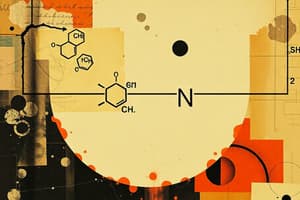Podcast
Questions and Answers
In the SN1 mechanism, the rate-determining step involves:
In the SN1 mechanism, the rate-determining step involves:
- Simultaneous attack of the nucleophile and departure of the leaving group
- Direct interaction between the nucleophile and the substrate
- Formation of a carbocation (correct)
- Partial attachment of the nucleophile to the carbon before departure of the leaving group
The SN2 mechanism is characterized by:
The SN2 mechanism is characterized by:
- Formation of a stable carbocation intermediate
- Partial attachment of the nucleophile to the carbon before departure of the leaving group
- Multiple steps involving the nucleophile and leaving group
- Simultaneous displacement of the leaving group and attack by the nucleophile (correct)
In the hydrolysis of bromomethane in aqueous base, the energy necessary for breaking the C-Br bond is supplied by:
In the hydrolysis of bromomethane in aqueous base, the energy necessary for breaking the C-Br bond is supplied by:
- Formation of the HO-C bond (correct)
- Formation of a stable carbocation intermediate
- Approach by -OH along the line of centers of the C & Br
- Quantum mechanical calculation
The approach by -OH along the line of centers of the C & Br is associated with:
The approach by -OH along the line of centers of the C & Br is associated with:
The transition state for SN2 mechanism involves:
The transition state for SN2 mechanism involves:
In the SN1 mechanism, the rate of the reaction depends on:
In the SN1 mechanism, the rate of the reaction depends on:
In the SN2 mechanism, the stereochemistry of the product shows:
In the SN2 mechanism, the stereochemistry of the product shows:
In the hydrolysis of bromomethane in aqueous base, the rate-determining step involves:
In the hydrolysis of bromomethane in aqueous base, the rate-determining step involves:
In the SN2 mechanism, the nucleophile attacks the carbon atom:
In the SN2 mechanism, the nucleophile attacks the carbon atom:
The hydrolysis of bromomethane in aqueous base is classified as:
The hydrolysis of bromomethane in aqueous base is classified as:
Flashcards are hidden until you start studying
Study Notes
SN1 Mechanism
- The rate-determining step involves a unimolecular process
- The rate of the reaction depends on the concentration of the substrate
SN2 Mechanism
- Characterized by a bimolecular process
- The transition state involves a pentacoordinate carbon atom
- The nucleophile attacks the carbon atom from the backside, resulting in an inversion of stereochemistry
- Stereochemistry of the product shows an inversion of configuration
Hydrolysis of Bromomethane
- The energy necessary for breaking the C-Br bond is supplied by the aqueous base
- The rate-determining step involves a bimolecular process
- Classified as an SN2 reaction
Studying That Suits You
Use AI to generate personalized quizzes and flashcards to suit your learning preferences.




